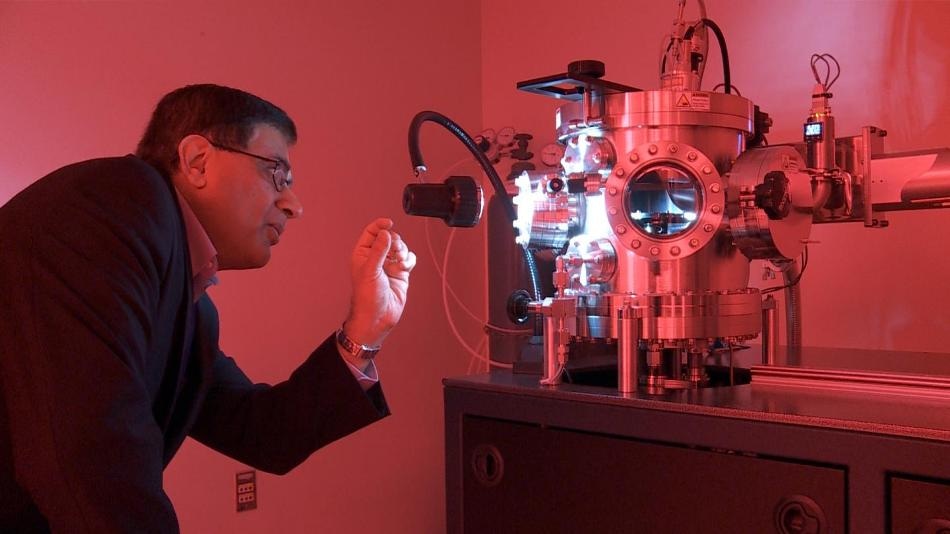Oct 19 2016
 Yogesh Vohra. (Credit – UAB)
Yogesh Vohra. (Credit – UAB)
Researchers at the University of Alabama at Birmingham are set to apply pressures greater than those known to exist at the center of the Earth to potentially develop yet unidentified new materials.
In nature, such enormous forces deep underground can transform volcanic ash into slate or carbon into diamonds.
The ability to generate these pressures depends on miniature nanocrystalline-diamond anvils produced in a UAB clean room manufacturing facility. Each anvil head measures only half the width of an average human hair. The first 27 prototypes are being tested and the limits of their pressure are still not reached.
We have achieved 75 percent of the pressure found at the center of the Earth, or 264 gigapascals, using lab-grown nanocrystalline-diamond micro-anvil. But the goal is one terapascal, which is the pressure close to the center of Saturn. We are one-quarter of the way there.
Yogesh Vohra, Ph.D., Professor, University of Alabama at Birmingham
A scientific measure of pressure, one terapascal, is equal to 147 million pounds per square inch.
One key to high pressure is to design the point of the anvil, where the pressure is applied, very narrow. This expands the pressure applied by a piston above the micro-anvil, much like the difference of being stepped on by a spiked high heel instead of a loafer.
A more challenging task is to find out a way to create an anvil that can survive this ultra-high pressure. The key for the Vohra team is to grow a nanocrystalline pillar of diamond - measuring 30 μm wide and 15 μm tall - on the culet of a gem diamond.
“We didn’t know that we could grow nanocrystalline diamonds on a diamond base,” Vohra said. “This has never been done before.”
In the 264 GPa pressure test at Argonne National Laboratory in Lemont, Illinois, the nanocrystalline diamond did not display any sign of deformation. Recently, Vohra and colleagues reported this result in the American Institute of Physics journal AIP Advances.
The structure did not collapse when we applied pressure. Nanocrystalline diamond has better mechanical properties than gem diamonds. The very small-sized grain structure makes it really tough.
Yogesh Vohra, Ph.D., Professor, University of Alabama at Birmingham
As more micro-anvils are examined and optimized, they will be used to analyze how alloys, transition metals, and rare earth metals act under challenging conditions. In the same way as graphitic carbon subjected to high pressure and temperature turns into diamond, certain materials pressured by the micro-anvils are likely to gain novel crystal modifications with improved mechanical and physical properties.
These modifications are retained when the pressure is discharged. Such new materials hold promise in potential applications in industries such as biomedical, aerospace, and nuclear.
The micro-anvils are created in a Class 7000 clean room in the UAB Diamond Microfabrication Lab, using microwave plasma chemical vapor deposition and maskless lithography.
Vohra says his team is focused on producing smaller grain sizes in the nanocrystalline diamond, which may make it a lot stronger; understanding the way nanocrystalline diamond is bonded to the gem diamond; and using ion beams to design the top of the micro-anvil to take on a hemispherical shape. The hemispherical shape will enable an even narrower contact point, thus escalating the pressure.
Testing is performed at Argonne as it has an extremely bright synchrotron X-ray source that can investigate crystal structure of micron-sized materials under pressure. Vohra, along with two graduate students, travel to Argonne nearly four times a year.
Besides Vohra, authors of the AIP Advances paper, “Nanocrystalline diamond micro-anvil grown on single crystal diamond as a generator of ultra-high pressures,” are Gopi K. Samudrala, Samuel L. Moore, Georgiy M. Tsoi, Paul A. Baker, all of the UAB Department of Physics; and Nenad Velisavljevic, Los Alamos National Laboratory, New Mexico.
The work was supported by three-year grants from the National Science Foundation, and the U.S. Department of Energy totaling $833,000 for 2016 to 2019, and also by Carnegie DOE Alliance Center graduate training support under grant DE-NA002006. The test facilities at Argonne National Laboratory are supported by Department of Energy awards and contracts.